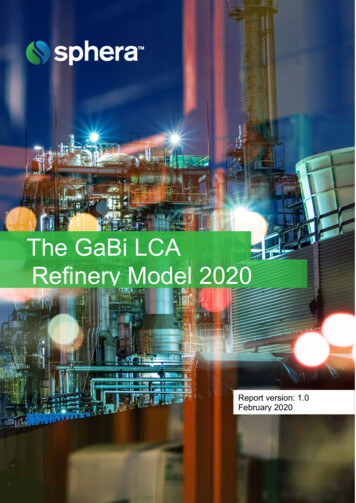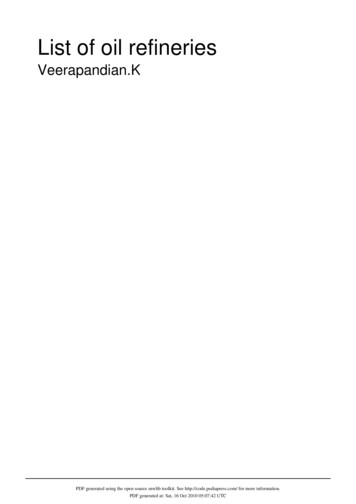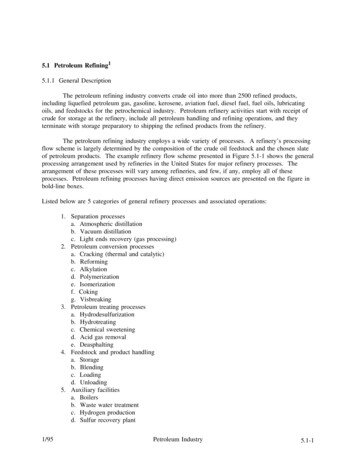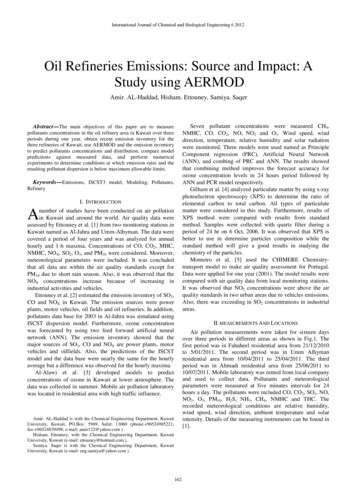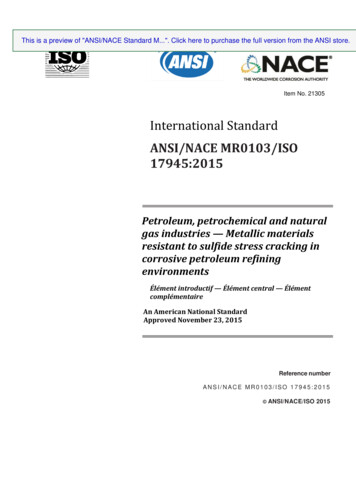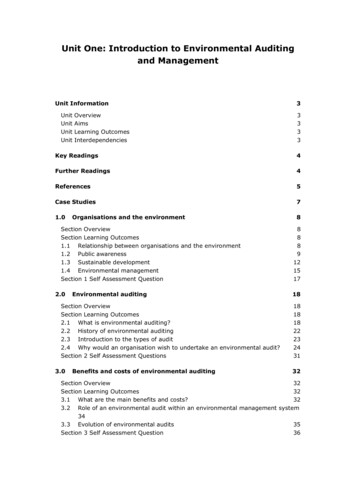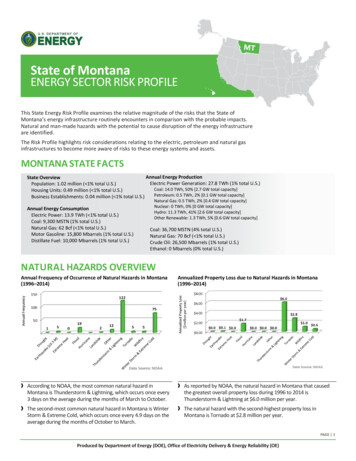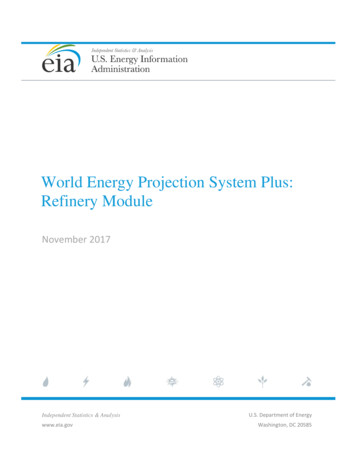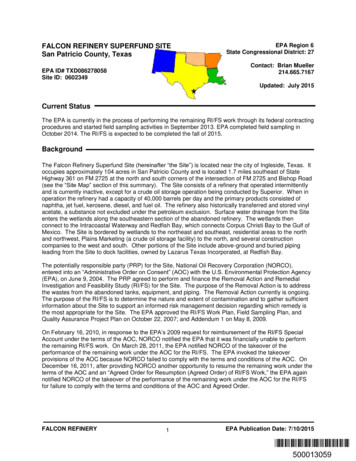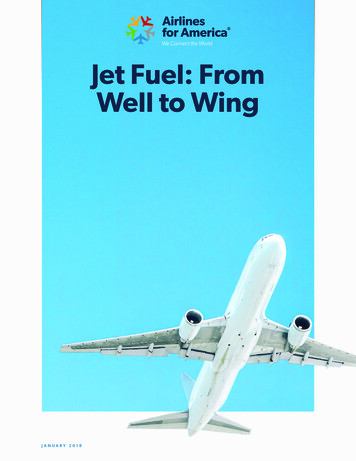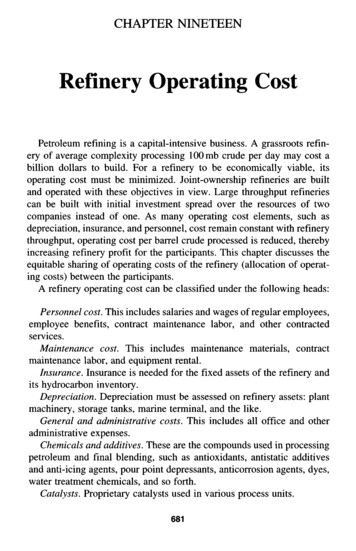
Transcription
CHAPTER NINETEENRefinery Operating CostPetroleum refining is a capital-intensive business. A grassroots refinery of average complexity processing 100 mb crude per day may cost abillion dollars to build. For a refinery to be economically viable, itsoperating cost must be minimized. Joint-ownership refineries are builtand operated with these objectives in view. Large throughput refineriescan be built with initial investment spread over the resources of twocompanies instead of one. As many operating cost elements, such asdepreciation, insurance, and personnel, cost remain constant with refinerythroughput, operating cost per barrel crude processed is reduced, therebyincreasing refinery profit for the participants. This chapter discusses theequitable sharing of operating costs of the refinery (allocation of operating costs) between the participants.A refinery operating cost can be classified under the following heads:Personnel cost. This includes salaries and wages of regular employees,employee benefits, contract maintenance labor, and other contractedservices.Maintenance cost. This includes maintenance materials, contractmaintenance labor, and equipment rental.Insurance. Insurance is needed for the fixed assets of the refinery andits hydrocarbon inventory.Depreciation. Depreciation must be assessed on refinery assets: plantmachinery, storage tanks, marine terminal, and the like.General and administrative costs. This includes all office and otheradministrative expenses.Chemicals and additives. These are the compounds used in processingpetroleum and final blending, such as antioxidants, antistatic additivesand anti-icing agents, pour point depressants, anticorrosion agents, dyes,water treatment chemicals, and so forth.Catalysts. Proprietary catalysts used in various process units.
Royalties. Royalties are paid either in a lump sum or running royaltypurchased for know-how.Purchased utilities. This may include electric power, steam, water,and so on.Purchased refinery fuel. This may include natural gas purchased by therefinery for use as refinery fuel and feedstock for hydrogen production.ALLOCATION OF OPERATING COSTIn a jointly-operated refinery, the individual operating expenses underdifferent cost headings, as just described, can be allocated to the participants by one of the following methods: the system costing method, thetheoretical sales realization valuation (TSRV) method, or on an actualusage basis.SYSTEM COSTING METHODIn the system costing method, costs are allocated to a participant inthe ratio of its equity in the refinery AU operating expenses involved inprocessing feedstocks in the refinery and related general and administrative services are allocated in this manner. The portion of currentoperating expenses related to major maintenance and repair items, suchas unit shutdowns, emergency repairs, and large expenditure on replacements and renewals, which do not extend the life of fixed assets, aresegregated. These are spread over a 12-month period by including in theoperating expenses for each operating period, a monthly amount equalto l/12th the estimated amount of such expenses, ensuring a 12-monthperiod to recover the actual expenditure.THEORETICAL SALES REALIZATIONVALUATION METHODIn the TSRV method, the total expense is allocated to the participantsin the ratio of TSRV of its product. The following example illustrates themethodology involved.
EXAMPLE 19-1The total operating expenses of a marine terminal of a refinery during amonth were 1.3 million. We want to allocate these expenses to theparticipants using the TSRV method. The product shipments during themonth from the terminal were as follows:PRODUCTAOCS SHIPMENTS, bblBOCS SHIPMENTS, bblNAPHTHAGASOLINEKEROSENEDIESELFUEL 46150,8321,579,648The first step in allocating the cost by the TSRV method is to estimatethe value of the product shipped by both the participants. This is done bymultiplying the shipment volumes by per unit cost of the product asfollows. The cost used here is the average mean of Platts (MOP) published prices of the products during the SPHALTTOTALMOP PRICE, /bblAOC SHIPMENTS, millionsBOC SHIPMENTS, 77.1333.3690.50820.577Total value of the product shipped overmarine terminal 131,208 millionValue of the product shipped by participant AOC 110.631 millionValue of the product shipped by participant BOC 20,577 million
Total value of the product shipped 131.208 millionParticipant AOC s product share 84.0%Participant BOCs product share 16.0%Total operating expenses of the marine terminal 1.31 millionParticipant AOCs share of operating cost (84%) 1.092millionParticipant BOCs share of operating cost (16.0%) 0.121 millionCOST ALLOCATION FOR ACTUAL USAGEThe following cost items are allocated to the participants as per theiractual usage:1. The cost of the chemicals and additives, such as antiknock compounds, pour point depressants, and antistatic dissipaters. It ispossible to accurately estimate the quantity of antiknock compound,pour point depressants, and other additives used in the final blending of their products from shipment and quality data records.2. All operating expenses involved in receiving crude oil and otherfeedstocks in each operating period are segregated and allocated tothe participants on the basis of that received by each in the period.For example, if a participant brings in a crude or another feedstockfor processing in its share of refining capacity, all expenses relatedto receiving the crude is allocated to that participant. If a crude isbrought in by pipeline for processing by both the participants, thepipeline-related expense is allocated to the participants in the ratioof the crude received.3. All operating expenses involved in the manufacture and shipping ofsolid products, such as asphalt and sulfur, in each operating periodare segregated and allocated to the participants on the basis of theirrespective shares of shipment of such products.UNUSED CAPACITY CHARGEAfter each operating period, the refinery establishes the amount of totalcrude distillation capacity available to each participant during the
operating period but not used by that participant. The per-barrelcharge to be applied to payable unused capacity is calculated as follows.If we letTotal operating expenses during a month A (million )Total available refinery crude distillation capacityduring month B (mb)Per barrel capacity charge A/BSuppose the participants' equity in refinery is 60/40. The capacityavailable to participants during the month isAOC 0.65 mbBOC 0.45 mbIf one participant, say, BOC, utilizes only 95% of its available capacity,BOCs unused capacity 0.4 x 0.05Z? mb 0.02B mbUnused capacity charge payable by BOC [(A/B) x (0.02S)] millionThe unused capacity charges are deducted from the total operatingexpenses of the refinery before allocating these expenses to the participants. An example of monthly allocation of various cost elements in anactual refinery is shown in Table 19-1. In the table the total monthlyoperating expenses are shown in column 4. The basis of allocation of eachoperating expense is indicated in column 1.We see that Personnel, maintenance, insurance for the refinery plant and machinery, depreciation, royalties, catalyst costs, and so forth are allocatedon the basis of participant equity in the refinery. Insurance for the hydrocarbon inventory in the refinery's tanks is onthe basis of average inventory held by each participant. Natural gas import costs are allocated to the participants in the ratioof their usage in the allocation LPs.
Table 19-1Monthly Allocation of Various Cost INVENTORYTAXES/LICENCESDEPRECIATIONNATURAL RUDE RECEIVINGPIPELINEMARINE TERMINALASPHALT PRODUCTIONASPHALT DRUM FILLINGSULFUR PLANTTOTALBASIS OFALLOCATION(1)AOCALLOCATION, (2)BOCALLOCATION, (3)TOTALEXPENSE, 500EQUITYINV. RATIOEQUITYEQUITYUSAGEUSAGEEQUITYEQUITYCRUDE RUNCRUDE CTIONPRODUCTIONTOTAL CRUDE UITY
Chemical and additive costs is allocated to the participants on thebasis of actual usage. For example, the cost of anti-icing additivesused for blending jet fuel by one participant can be estimated fromthe volume of jet fuel blended and the additive dosage rate. Foradditives and chemicals whose use by an individual participantcannot be identified is allocated in the ratio of the crude run of theparticipant. Utilities costs are allocated on the basis of the participant's crude run. If crude is received by way of a pipeline for use of more than oneparticipant, all pipeline expenses are allocated to the participants inthe ratio of their crude run in the refinery. If crude or feedstock isreceived by refinery for exclusive use of one participant, all expensesrelating to that import are allocated to the receiving participant. All expenses relating to product export from the refinery marineterminal are allocated by the TSRV method. In this method, thevalue of total product exported by each participant is estimated andthe total operating expenses of the terminal is allocated in that ratio.An example of the methodology involved is shown in Example 19-1. Asphalt production and drumming is a noncontinuous activity inmany refineries. Special operating costs, such as drum filling, aresegregated from other unit operating costs and allocated to participants in the ratio of the product shipped. Similarly, sulfur plantspecial costs, such as prilling plant costs, are allocated to participantsin the ratio of their sulfur shipped.REVENUES FROM LEASING EXCESS TANKAGE CAPACITYA situation can arise in which the refinery has excess storage capacityavailable over that required for operation of the refinery at its maximumcrude throughput. In such situation, the refinery can lease its surplustankage capacity on a long-term lease to other companies for storage ofits products and earn some extra profit. Any profit from such an operationis split between the participants in the ratio of their equity in the refinery.EXAMPLE 19-2A jointly owned company is awarded a tender from the DefenseDepartment to store 1 million bbl petroleum products for a period of5 years. The products comprise the following:
PRODUCTSVOLUME, bblKEROSENE/JET FUELAUTOMOTIVE DIESELFUEL OILTOTAL STORED350,000300,000350,0001,000,000The business is offered to the refinery, at 5.00/bbl/year. The refinery,however, has to use one storage tank of 500 mb capacity built exclusivelyfor participant BOC, in addition to its own excess tankage capacity, tomeet the storage capacity required for this business. The equity of theparticipants in the refinery is 60 and 40%. The participants agree to sharerevenues from this venture 50:50. Estimate net revenue of each participant from this business.Total revenue from leasing tankage capacity 1 million x 5 5 million/year. The revenue sharing of 5 million per year will be50:50, as follows, for the 5-year period of the contract.YEAR12345TOTALAOC REVENUE, millionBOC REVENUE, million2.52.52.52.52.52.52.52.52.52.512.512.5To provide the required storage capacity, participant BOC leases itsexclusively owned tank of 500 mb capacity to the refinery for this business at 5.0bbl/year for a period of 5 years. As the equity of participantsin the refinery is 60:40 for AOC and BOC, the revenue of the participantswill be as follows:Capacity of participant BOC tank leasedto the refinery 500 mbAnnual lease charge payable to the participant BOC 500,000 x 5- 2 . 5 million
This lease cost is shared between the participants in their equity ratio(60/40 here), as follows:LEASE COST, 57.51.01.01.01.01.05.02.52.52.52.52.512.5Revenue to BOC from leasing the tank to refinery, because of itsownership of the leased tank, is as follows:YEAR12345TOTALREVENUE TOBOC, million2.52.52.52.52.512.5The net profit to each participant from storage tender and participantBOC leasing its tank can be determined as follows:Participant AOC 2.5 - 1.5 1.0 million/yearParticipant BOC 2.5 - 1.0 2.5 4.0 million/year.
CUMULATIVE REVENUE, .0TOTAL5.020.0We see that the total revenue of the participants remains constant at 25 million, after 5 years of business. However, the split of this revenuebetween the participants has changed from 50:50 without BOC tankleasing to the refinery, to 20/80 in participant BOC favor as a result oftank leasing.
Refinery Operating Cost Petroleum refining is a capital-intensive business. A grassroots refin-ery of average complexity processing 100 mb crude per day may cost a billion dollars to build. For a refinery to be economically viable, its . FUEL OIL 1,706,555 376,461 ASPHALT 29,221 50,832 TOTAL 5,498,505 1,579,648
